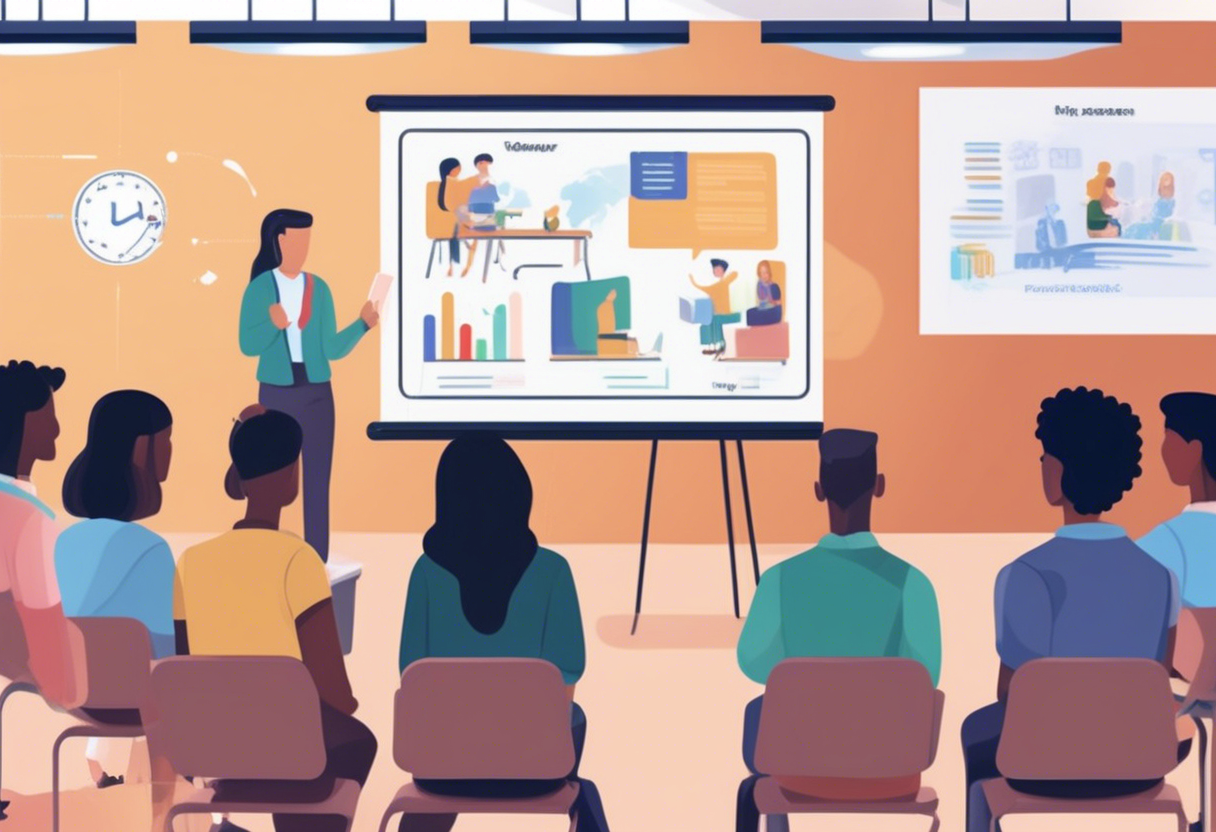
Public speaking classes have been the go-to for mastering eloquence and persuasion. But did you know that about 75% of people fear public speaking more than death? Yep, it's true. While traditional methods work, the digital age brings us a new helper: Artificial Intelligence. Think of it as a personal coach that never gets tired, always listens, and gives you feedback right away, just for you. In this article, we’ll look at how AI is changing public speaking classes, helping turn nerves into confidence and changing the way we learn to engage an audience. Whether you're a seasoned pro or just starting out, AI might be what you need to boost your skills. Let's explore how technology meets the art of speaking!
Summary: This article explores the integration of AI in public speaking classes, highlighting its transformative impact, practical applications, and the synergy between AI and human coaching. It also addresses common questions about the use of AI in enhancing public speaking skills.
Understanding Public Speaking Classes and Their Challenges
Importance of Public Speaking Skills in Personal and Professional Growth
Public speaking plays a crucial role in both personal and professional development. Regular practice can significantly boost your confidence by alleviating the anxiety associated with speaking in front of an audience. It also enhances mental acuity, as it requires you to organize your thoughts clearly and logically.
On the professional front, proficiency in public speaking can unlock numerous opportunities. It enhances your communication, leadership, networking, and negotiation skills. Additionally, it establishes your credibility, enabling you to present ideas effectively and distinguish yourself in the workplace. Training in public speaking not only refines verbal and nonverbal communication but also benefits from continuous feedback and practice.

Overcoming the fear of public speaking, known as glossophobia, is a significant personal achievement. With consistent practice, this anxiety diminishes. Public speaking also hones your research skills since you need robust information to support your arguments. It bolsters leadership capabilities by improving team engagement, decision-making, and persuasion. These advantages underscore the immense value of public speaking across various life aspects.
Traditional Public Speaking Classes: Methods and Challenges
Traditional public speaking classes focus on enhancing oral communication skills through practice and feedback. They are effective in reducing nervousness by acclimating individuals to public speaking and teaching strategies to manage fear. However, there are limitations to this approach.
- Audience Engagement: Maintaining interest and conveying complex information can be challenging.
- Stage Fright: Many individuals struggle with stage fright and clear delivery, necessitating ongoing practice beyond the classroom.
- Modern Trends: These classes often overlook contemporary trends such as virtual presentations, interactive audience engagement, and leveraging technology like AI for coaching.

While traditional classes cover essential fundamentals—such as storytelling, speech organization, positive body language, audience interaction, and handling difficult questions—the one-size-fits-all methodology may not suit everyone. This highlights the need for more flexible and personalized public speaking training.
Public speaking enhances self-confidence
Effective public speaking builds credibility
Traditional public speaking classes focus on practicing oral communication skills
Limitations include the challenge of maintaining audience engagement
How AI is Transforming Public Speaking Classes
AI Integration in Public Speaking Training
AI and VR are transforming the way we train for public speaking by offering realistic simulations. These technologies allow you to practice speaking to a boardroom or a large crowd, boosting your confidence and effectiveness. AI virtual assistants, such as those utilizing Amazon Bedrock, can transcribe your speech and check for grammar mistakes, filler words, and repetition. They provide tips to enhance your delivery and communication skills.

AI employs smart algorithms and machine learning to deliver personalized and scalable training, including real-time feedback and systems that adapt to your learning pace. This approach has proven successful in various settings. For instance, Verizon's VR training has improved empathy and service skills, while schools like Vodafone have experienced a 91% increase in demand for VR-based training, highlighting AI's significant impact on public speaking education.
AI Tools and Technologies for Public Speaking
Real-Time Speech Analysis Tools
AI coaches, like Poised, analyze your speech in real-time to help you eliminate filler words, speak clearly, and build confidence during meetings or presentations. Yoodli offers instant feedback, aiding improvement in presentations, interviews, or pitches. Amazon Bedrock enables the creation of AI virtual assistants that transcribe and analyze speeches, providing automated, personalized coaching to refine your public speaking.
VR Simulators for Public Speaking Practice
VR simulations offer a realistic yet safe environment to practice public speaking, reducing anxiety and enabling skill retention without a live audience. Platforms like VirtualSpeech provide AI-driven soft skills training, including public speaking, through VR and online exercises, with feedback after each session. This method can enhance skills up to four times faster, with users generally reporting satisfaction.
AI-Driven Audience Feedback Systems
AI tools deliver instant, unbiased feedback and track your progress, making learning more efficient than traditional coaching. This feedback allows you to adjust your delivery in real-time, ensuring your message resonates with the audience.
Adaptive Learning Platforms for Public Speaking
AI tools in public speaking classes provide immediate feedback on pronunciation, fluency, grammar, and vocabulary. They adapt to your needs and skill level, boosting confidence and accelerating skill acquisition. These platforms offer a pressure-free practice environment, on-demand access, and are more affordable than human coaches, though they might not capture the nuances of human feedback.
For more information on AI in public speaking, explore the following resources:
Practical Applications and Benefits of AI in Public Speaking
Real-Time Feedback in Public Speaking Classes
AI tools are revolutionizing public speaking coaching by providing instant, personalized feedback on elements such as tone, pacing, articulation, and body language. This real-time feedback allows speakers to identify areas for improvement, making their speeches more engaging and effective.
For example, platforms like Orai act as personal speech coaches. They analyze speaking habits and offer immediate feedback. These tools are accessible anytime, enabling users to continuously practice and refine their skills.
AI platforms employ adaptive learning systems to tailor coaching paths based on individual performance, making public speaking training more personalized. This approach provides learners with guidance that suits their unique needs, helping them develop their own speaking style.
Some AI tools even feature virtual coaches and simulations that replicate real audience settings, offering a safe space for practice and guidance. An example is an AI-enabled VR platform from Cambridge that provides personalized coaching and immersive practice environments. This helps users build skills and confidence with tailored feedback during simulated speeches.
Boosting Confidence in Public Speaking Classes
Public speaking anxiety is common, and AI is helping individuals address it by boosting confidence and alleviating nerves. AI-driven simulations allow users to practice public speaking in virtual environments that mimic real audience scenarios. This exposure therapy aids in reducing anxiety and building confidence safely.
Studies indicate that using AI platforms can increase confidence and enjoyment in public speaking, even after just one 30-minute session, with lasting benefits from repeated use.
AI coaching assists users in managing symptoms of glossophobia, such as a racing heart or shaky voice, by providing gradual exposure and coping strategies. Self-guided AI training over a week can enhance adaptability, resilience, and preparedness, thereby reducing anxiety.

A notable example is a free AI-enabled VR platform launched by a Cambridge scientist. It transforms anxious novices into confident speakers by offering immersive practice and anxiety management tools.
Non-Verbal Communication Skills in Public Speaking Classes
Non-verbal communication is crucial to effective public speaking, and AI is stepping in to help individuals master body language, facial expressions, and eye contact. AI tools analyze non-verbal cues during speeches to provide feedback on audience engagement and speaker effectiveness. This feedback helps speakers become aware of unconscious habits and improve their stage presence.
For instance, AI systems offer feedback on posture, gestures, and facial expressions during practice, aiding speakers in enhancing non-verbal communication to better engage audiences.
Advanced AI tools can simulate realistic audience reactions, allowing speakers to practice and refine their non-verbal communication in a controlled setting. Data-driven AI insights enable continuous improvement in non-verbal skills by highlighting patterns and areas needing attention over time.
By incorporating AI insights into their practice, learners can enhance their overall presentation skills and make a stronger impact on their audience.

These AI advancements are transforming public speaking classes, offering tools and techniques previously unavailable. As AI continues to evolve, its role in enhancing public speaking skills will expand, providing learners with even more opportunities to excel.
AI Integration in Public Speaking Classes
Enhancing Public Speaking with AI and Human Coaching
Bringing together AI and human instructors in public speaking classes creates a dynamic learning environment. AI tools like ChatGPT and Orai offer:
- Data-driven insights
- Real-time feedback
- Personalized learning paths
These tools analyze speech patterns, emotional signals, and behavior, providing clear feedback on tone, pacing, and filler words. This immediate feedback helps students tweak and improve their skills on the spot, boosting their confidence and performance.

Human instructors bring emotional intelligence, personal mentoring, and nuanced guidance that AI can't fully match. They take AI insights and integrate them into a broader emotional and contextual framework, offering:
- Tailored support
- Delivery coaching
- Strategic advice
This blend of AI and human coaching makes training more scalable and consistent without losing the personal touch. Additionally, AI provides ongoing practice and motivation by offering coaching anytime, allowing learners to refine their skills outside regular sessions.
Developing a Public Speaking Curriculum with AI Tools
Creating a curriculum with AI tools involves leveraging them for:
- Personalized speech analysis
- Adaptive learning paths
- Simulating different audience scenarios
These elements build adaptability in learners. AI-driven exercises and feedback should complement live coaching sessions to cover:
- Emotional intelligence
- Body language
- Audience engagement skills
For instance, students might draft speeches with AI assistance, engage in AI-simulated Q&A, and then participate in live workshops with human coaches to focus on nonverbal communication and emotional presence.

It's crucial to address ethics, such as data privacy and responsible AI use, in curriculum planning to maintain trust and safety. AI tools can assess vocal tone, speech clarity, and emotional expression, providing learners with clear, actionable feedback to enhance delivery. Encouraging learners to practice with AI tools outside class helps retain skills and build confidence. This thoughtful integration of AI and traditional coaching creates a well-rounded and effective learning setup for public speaking.
FAQs About AI in Public Speaking Classes
How Effective is AI for Reducing Anxiety in Public Speaking Classes?
AI is quite effective at easing public speaking jitters through immersive simulations and real-time feedback. With virtual reality (VR), AI-powered training allows you to practice in environments that feel authentic—think large audiences or formal meetings. This setup enables practice without the pressure, significantly helping with anxiety. For instance, Bank of America's VR training program demonstrated a 97% boost in user confidence, highlighting AI's significant role in calming nerves.

Additionally, AI acts as a virtual assistant, analyzing your speech in real time. It identifies filler words and grammar slips, providing the necessary feedback to enhance your preparation. This builds confidence, which is crucial for managing anxiety. By combining realistic practice with targeted feedback, AI helps you feel more assured when addressing a real audience.
Can AI Tools Enhance Non-Verbal Communication in Public Speaking Classes?
AI tools are increasingly adept at assisting with the non-verbal aspects of public speaking, which are crucial for effective communication. Through VR and AI, you can practice body language, eye contact, and gestures in realistic settings. This practice enhances your non-verbal skills, making you a more engaging speaker.
While not all AI tools provide explicit non-verbal feedback, some offer real-time insights into your speech, indirectly aiding non-verbal communication by improving pacing and clarity, thereby boosting confidence. Personalized AI systems utilize smart algorithms to tailor coaching, including non-verbal cues, enhancing your overall speaking abilities.
For example, VirtualSpeech provides VR environments where you can work on eye contact and gestures in simulated real-life situations. These tools help you become more expressive and relatable, ultimately elevating your public speaking skills.
What Are the Limitations of AI in Public Speaking Classes?
Despite its advancements, AI has clear limitations in public speaking training. A significant drawback is that AI cannot fully understand human emotions and context like a human coach can. This limitation means it might not effectively address complex anxiety or detect subtle non-verbal cues, resulting in feedback that may feel mechanical or disconnected.
Additionally, concerns about data privacy and ethical issues can hinder AI's widespread use and effectiveness in public speaking training. It's crucial to understand how your data is managed and the risks of unauthorized access.

Moreover, AI often focuses more on verbal elements—such as language use and pacing—while giving less attention to non-verbal communication like body language and facial expressions. The effectiveness of AI depends significantly on the quality of its training data and algorithms, which may not adapt well to varying cultural and personal speaking styles.
While AI offers substantial benefits, it should complement human coaching and feedback. Combining AI insights with human judgment ensures that your speech adjustments are contextually appropriate, providing a more comprehensive approach to public speaking training. Platforms like Duarte offer insights into what AI coaching platforms excel at and where they may fall short.